[English] 日本語
 Yorodumi
Yorodumi- PDB-7fec: Cryo-EM structure of the nonameric SsaV cytosolic domain with C9 ... -
+ Open data
Open data
- Basic information
Basic information
| Entry | Database: PDB / ID: 7fec | ||||||
|---|---|---|---|---|---|---|---|
| Title | Cryo-EM structure of the nonameric SsaV cytosolic domain with C9 symmetry | ||||||
 Components Components | Secretion system apparatus protein SsaV | ||||||
 Keywords Keywords | PROTEIN TRANSPORT / transporter | ||||||
| Function / homology |  Function and homology information Function and homology information | ||||||
| Biological species |  Salmonella enterica subsp. enterica serovar Typhimurium str. LT2 (bacteria) Salmonella enterica subsp. enterica serovar Typhimurium str. LT2 (bacteria) | ||||||
| Method | ELECTRON MICROSCOPY / single particle reconstruction / cryo EM / Resolution: 3.64 Å | ||||||
 Authors Authors | Xu, J.H. / Zhang, Y.Q. / Gao, X. | ||||||
| Funding support |  China, 1items China, 1items
| ||||||
 Citation Citation |  Journal: Microbiol Spectr / Year: 2021 Journal: Microbiol Spectr / Year: 2021Title: Structural and Functional Analysis of SsaV Cytoplasmic Domain and Variable Linker States in the Context of the InvA-SsaV Chimeric Protein. Authors: Jinghua Xu / Jiuqing Wang / Aijun Liu / Yanqing Zhang / Xiang Gao /  Abstract: The type III secretion (T3S) injectisome is a syringe-like protein-delivery nanomachine widely utilized by Gram-negative bacteria. It can deliver effector proteins directly from bacteria into ...The type III secretion (T3S) injectisome is a syringe-like protein-delivery nanomachine widely utilized by Gram-negative bacteria. It can deliver effector proteins directly from bacteria into eukaryotic host cells, which is crucial for the bacterial-host interaction. Intracellular pathogen Salmonella enterica serovar Typhimurium encodes two sets of T3S injectisomes from Salmonella pathogenicity islands 1 and 2 (SPI-1 and SPI-2), which are critical for its host invasion and intracellular survival, respectively. The inner membrane export gate protein, SctV (InvA in SPI-1 and SsaV in SPI-2), is the largest component of the injectisome and is essential for assembly and function of T3SS. Here, we report the 2.11 Å cryo-EM structure of the SsaV cytoplasmic domain (SsaV) in the context of a full-length SctV chimera consisting of the transmembrane region of InvA, the linker of SsaV (SsaV) and SsaV. The structural analysis shows that SsaV exists in a semi-open state and SsaV exhibits two major orientations, implying a highly dynamic process of SsaV for the substrate selection and secretion in a full-length context. A biochemical assay indicates that SsaV plays an essential role in maintaining the nonameric state of SsaV. This study offers near atomic-level insights into how SsaV and SsaV facilitate the assembly and function of SsaV and may lead to the development of potential anti-virulence therapeutics against T3SS-mediated bacterial infection. Type III secretion system (T3SS) is a multicomponent nanomachine and a critical virulence factor for a wide range of Gram-negative bacterial pathogens. It can deliver numbers of effectors into the host cell to facilitate the bacterial host infection. Export gate protein SctV, as one of the engines of T3SS, is at the center of T3SS assembly and function. In this study, we show the high-resolution atomic structure of the cytosolic domain of SctV in the nonameric state with variable linker conformations. Our first observation of conformational changes of the linker region of SctV and the semi-open state of the cytosolic domain of SctV in the full-length context further support that the substrate selection and secretion process of SctV is highly dynamic. These findings have important implications for the development of therapeutic strategies targeting SctV to combat T3SS-mediated bacterial infection. | ||||||
| History |
|
- Structure visualization
Structure visualization
| Movie |
 Movie viewer Movie viewer |
|---|---|
| Structure viewer | Molecule:  Molmil Molmil Jmol/JSmol Jmol/JSmol |
- Downloads & links
Downloads & links
- Download
Download
| PDBx/mmCIF format |  7fec.cif.gz 7fec.cif.gz | 507.2 KB | Display |  PDBx/mmCIF format PDBx/mmCIF format |
|---|---|---|---|---|
| PDB format |  pdb7fec.ent.gz pdb7fec.ent.gz | 428.3 KB | Display |  PDB format PDB format |
| PDBx/mmJSON format |  7fec.json.gz 7fec.json.gz | Tree view |  PDBx/mmJSON format PDBx/mmJSON format | |
| Others |  Other downloads Other downloads |
-Validation report
| Summary document |  7fec_validation.pdf.gz 7fec_validation.pdf.gz | 860.6 KB | Display |  wwPDB validaton report wwPDB validaton report |
|---|---|---|---|---|
| Full document |  7fec_full_validation.pdf.gz 7fec_full_validation.pdf.gz | 905.8 KB | Display | |
| Data in XML |  7fec_validation.xml.gz 7fec_validation.xml.gz | 84.3 KB | Display | |
| Data in CIF |  7fec_validation.cif.gz 7fec_validation.cif.gz | 110.1 KB | Display | |
| Arichive directory |  https://data.pdbj.org/pub/pdb/validation_reports/fe/7fec https://data.pdbj.org/pub/pdb/validation_reports/fe/7fec ftp://data.pdbj.org/pub/pdb/validation_reports/fe/7fec ftp://data.pdbj.org/pub/pdb/validation_reports/fe/7fec | HTTPS FTP |
-Related structure data
| Related structure data |  31552MC  7febC  7fedC M: map data used to model this data C: citing same article ( |
|---|---|
| Similar structure data |
- Links
Links
- Assembly
Assembly
| Deposited unit | 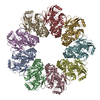
|
|---|---|
| 1 |
|
- Components
Components
| #1: Protein | Mass: 38124.180 Da / Num. of mol.: 9 Source method: isolated from a genetically manipulated source Source: (gene. exp.)  Salmonella enterica subsp. enterica serovar Typhimurium str. LT2 (bacteria) Salmonella enterica subsp. enterica serovar Typhimurium str. LT2 (bacteria)Strain: LT2 / Gene: ssaV, STM1414 / Production host:  |
|---|
-Experimental details
-Experiment
| Experiment | Method: ELECTRON MICROSCOPY |
|---|---|
| EM experiment | Aggregation state: PARTICLE / 3D reconstruction method: single particle reconstruction |
- Sample preparation
Sample preparation
| Component | Name: export gate protein of type III secretion system / Type: ORGANELLE OR CELLULAR COMPONENT / Entity ID: all / Source: RECOMBINANT |
|---|---|
| Source (natural) | Organism:  Salmonella enterica subsp. enterica serovar Typhimurium str. LT2 (bacteria) Salmonella enterica subsp. enterica serovar Typhimurium str. LT2 (bacteria) |
| Source (recombinant) | Organism:  |
| Buffer solution | pH: 8 |
| Specimen | Embedding applied: NO / Shadowing applied: NO / Staining applied: NO / Vitrification applied: YES |
| Vitrification | Cryogen name: ETHANE |
- Electron microscopy imaging
Electron microscopy imaging
| Microscopy | Model: FEI TITAN |
|---|---|
| Electron gun | Electron source:  FIELD EMISSION GUN / Accelerating voltage: 300 kV / Illumination mode: FLOOD BEAM FIELD EMISSION GUN / Accelerating voltage: 300 kV / Illumination mode: FLOOD BEAM |
| Electron lens | Mode: BRIGHT FIELD |
| Image recording | Electron dose: 50 e/Å2 / Film or detector model: GATAN K3 (6k x 4k) |
- Processing
Processing
| CTF correction | Type: PHASE FLIPPING AND AMPLITUDE CORRECTION |
|---|---|
| 3D reconstruction | Resolution: 3.64 Å / Resolution method: FSC 0.143 CUT-OFF / Num. of particles: 90916 / Symmetry type: POINT |
 Movie
Movie Controller
Controller






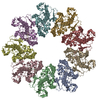
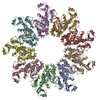
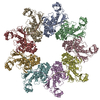
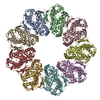


 PDBj
PDBj